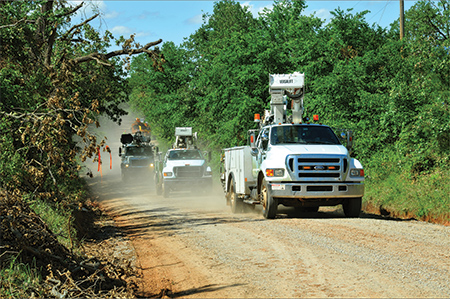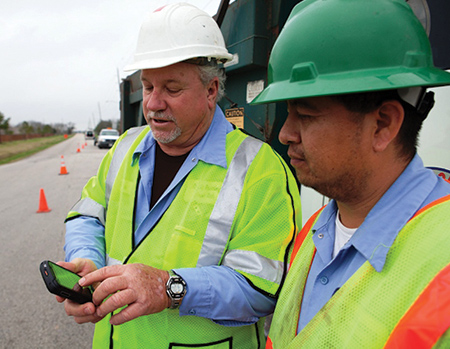Disasters of every kind prevail at movie theaters and on TV. Hollywood is skilled at portraying the chaos and life or death drama of disasters of both man-made and natural kinds. However, there are certain realities of these situations that you seldom see.
Imagine a night-time scene that is lit only by the flames of a building on fire. The police have established a perimeter. The fire department arrives with its trucks and hoses. A water supply line is established and just as the valve is about to open, the fire captain shouts into the radio: “Is the electricity off in the building?”
That last sentence adds a final dose of reality omitted in most melodrama. Someone is missing from the usual depictions of emergency response: the utility technician that is ensuring electricity and gas lines are secured. In most cases, firefighters will not put water on a flaming building unless they receive confirmation that utility personnel have turned off the building’s electricity. In other situations, restoring power is a race against the clock to maintain order and empower other emergency responders.
In reality, utility personnel are first emergency responders. Their efforts often enable other disaster responses and public safety. Planning for disaster response must include empowering and protecting these brave people.

Utility vehicles are dispatched after the storm passes to repair a local neighborhood outage
Communications is the front line of that empowerment and protection. Communication is always mission-critical. However, there is a big difference between communicating on a routine day and during a crisis. When the sun is shining and the city is safe, most utilities use some combination of public and private communication infrastructure.
However, when disaster strikes public infrastructure is at best unreliable as cellular bandwidth is either crippled by the disaster itself or the bandwidth is taken up with civilian traffic. The utility’s own private network is the sole mode of communication.

Two utility workers are operating their handheld mobile computer to complete a request processed by dispatch
The network must be architected to carry all communication in a crisis. That requires a planning process that incorporates worst-case scenarios, best-known methods and a real understanding of the local community from its geography to its potential hot spots in a disaster. Service delivery and personnel safety must share top spot in the priority list.
Disaster Response Prep for Utilities
In planning for disaster response, keep in mind the following utility personnel needs:
Hardened infrastructure: Reliability in a crisis involves a wide range of decisions that must be made long before the crisis. How tall are your towers? The antennas have to be high enough to create the required coverage. How much backup power is available? It needs to sustain the communications system for days. How much bandwidth are you making available? You need enough bandwidth for any conceivable situation.
That infrastructure must also be resilient to withstand cascading issues from storms, floods, and other disasters. The architecture needs built-in redundancy so that it operates when personnel need it. Antenna towers, buildings and equipment also have certain regulations and specifications that have to be followed – such as appropriate grounding – to be useful in a crisis.
Multi-directional communications: Any disaster response situation is dangerous. First responders have unique needs that have to be met amidst the race to fix downed power lines in a major storm or potentially ruptured gas lines in an explosion.
Utility responders need multi-directional communications. They need to coordinate among themselves in the field and with other emergency responders. They also need to be able to talk with dispatch and personnel in the power plant or other centralized facilities. For instance, electrical power lines carry massive amounts of power. The most dangerous part of repairing a broken electrical circuit is the moment when it is switched back on. Personnel at the site and at the Operations Center need to be in constant communication to ensure safety. This need for multi-directional communications has implications for antenna placement, bandwidth, radio quality as well as policies and procedures.
Choosing Technology Providers Wisely
Ensuring efficiency and worker safety is ultimately a question of planning, products and communications infrastructure. Fortunately, municipalities and other agencies do not have to take on this enormous burden alone. While every situation is unique, individual aspects of a situation have likely been seen elsewhere. Advisors and best-known methods are available. When choosing a vendor, it is worth keeping a couple simple things in mind.
Resources: Know how much you are taking on in the planning process. It is a big job with many moving parts and different kinds of subject matter expertise. You need to understand your resources and where you truly bring relevant expertise. Targeting your own resources to areas where you are the experts sheds tremendous light on what you need in a vendor. For instance, items that relate specifically to geography – things like tower locations, existing shelters and private backhaul – might well be an area of focus that your company can take responsibility for. Subjects that involve how much bandwidth is needed for needed applications, required RF coverage, frequency allocation and other technical matters might be areas where a vendor with experience in various localities can add value. A vendor should bring more than just products to the situation. They need to help you figure out the specific design, the implementation plan that minimizes user disruption and then supply the complete solution – both company supplied and other sourced equipment
Be there when disaster strikes: The best vendors are there when you need them. This actually means many things. In an impending crisis such as a storm, resources have to be staged to rush in once the storm passes. A vendor needs to be there to help with that staging. That might mean setting up temporary depots nearby or coordinating with reciprocating agencies. Many states have reciprocal agreements that allow resources to essentially mass just out of harm’s way and rush in after the storm passes. A vendor should be ready to be part of the team to help set up networks and coordinate temporary infrastructure.

Severed lines are being repaired by utility workers after a wind storm
Field forces are not the only vendor resource that is precious in a crisis. Radios are precious when people are depending on them to call for help and coordinate field and centralized personnel. Radio vendors should be able to shift their distribution system quickly to redirect radios coming off the manufacturing line to spots that are experiencing disasters or are prepping for impending disasters. Those vendors need strong relationships with other customers who will likely experience a delay in receiving their shipments. Such a vendor can credibly look that other customer in the eye and promise that they will get the same treatment when their moment of need arises.
Disaster preparedness is a necessary part of civic life in the 21st century. As a society, we are prepared to recognize police and firefighters in the emergency responder role. But, utility personnel are also among the first emergency responders in a disaster. They turn off power so fires can be fought. They turn on power so lights and other infrastructure can function. Utilities need a disaster response plan and that plan must be incorporated into a regional response plan. In Hollywood, happy endings are part of the business model. In reality, happy endings are the result of planning, hard work and choosing partners wisely.
About the Author
 Jeff Grosshauser is Area Sales Manager of North America Energy Markets, which is focused on US Utilities. In this vertical, Jeff leads the sales strategy and product solutions to meet current Energy market requirements and positions Motorola as a long term strategic technology partner with our customers. In Jeff’s previous role, he led a similar team focused on Fortune 500 customers. Jeff has held multiple leadership positions in his 28 years at Motorola including Account Management, Strategic Projects, Sales Management and Territory Management. He earned a bachelor’s degree in business from Augustana College, IL where he also lettered in football 4 years.
Jeff Grosshauser is Area Sales Manager of North America Energy Markets, which is focused on US Utilities. In this vertical, Jeff leads the sales strategy and product solutions to meet current Energy market requirements and positions Motorola as a long term strategic technology partner with our customers. In Jeff’s previous role, he led a similar team focused on Fortune 500 customers. Jeff has held multiple leadership positions in his 28 years at Motorola including Account Management, Strategic Projects, Sales Management and Territory Management. He earned a bachelor’s degree in business from Augustana College, IL where he also lettered in football 4 years.







